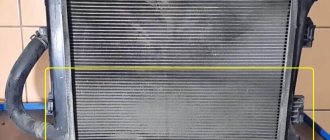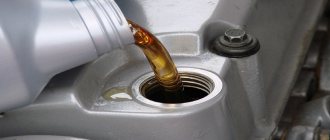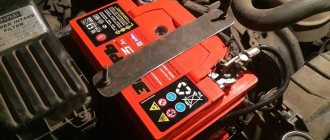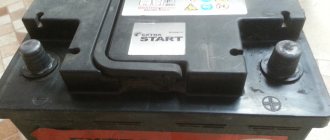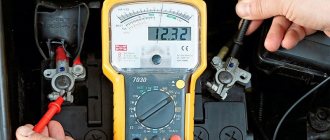The question “ how to check a car battery ” usually arises in two cases: when purchasing a new battery or if some kind of malfunction is discovered in the battery already under the hood. The cause of the malfunction can be either undercharging or overcharging of the battery.
Buying a new battery
If you have already met with the seller and want to be sure that if you buy a car, the first thing you will have to do is run headlong to the store for a new battery, which usually costs more than 10 thousand rubles, then you have several ways to check the battery by car:
- inspect the battery externally;
- measure the voltage on the battery with a multimeter;
- check the battery with a load fork;
- check the electrolyte level in the battery.
Types of energy savers
Low antimony
This is a common lead representative of automotive energy savers. It consists of lead, and a chemical element is added to the plates - antimony. They are easy to charge and have a tendency to self-discharge and rapidly boil away water.
Calcium
Electrically conductive elements are doped with calcium; thanks to this improvement, they do not require constant monitoring of the electrolyte level. Shaking in the car will not damage the energy saver due to increased vibration resistance. It is difficult to damage it by overcharging and can withstand voltages up to 14.8V.
Among the disadvantages - they are weak in relation to long-term discharges; if the energy drops to a value below 10.8V, they will irreversibly lose 50% of their original capacity. This energy saver is suitable for people who often travel long distances.
Hybrid
Combines the benefits of low-antimony and calcium energy sources. Tolerant to strong discharges and not fatally damaged by boiling.
How to check the battery yourself
Of all these methods, the most accessible to the average person is to use a tester to check the car battery and visually inspect it, and perhaps look inside (if the battery is serviceable) in order to see the color and electrolyte level. And to fully check the car battery for performance at home, you also need a densimeter and a load fork. Only in this way will the picture of the battery condition be as clear as possible.
Therefore, if there are no such devices, then the minimum actions that are available to everyone are to use a multimeter, a ruler and use regular consumers.
To test a battery without special equipment, you need to know its power (say, 60 Ampere/hour) and load it halfway with consumers. For example, by connecting several light bulbs in parallel. If after 5 minutes of operation they begin to glow dimly, it means the battery is not working as it should.
As you can see, such a home test is too primitive, so you can’t do without instructions on how to find out the real condition of a car battery. We will have to consider in detail the principles and all available testing methods, right down to measuring the density of the electrolyte and testing with a load simulating the operation of the starter.
We start with an external inspection
Since there is no way to start the engine without a car battery (you can, if you cheat), it is simply necessary to monitor the condition of the battery. Therefore, we need to have knowledge of how to check its functionality. Let's start with a visual inspection of the battery. It is necessary that its outer surface is clean and free of visible damage. The same applies to the condition of its terminals. It is often clear at this stage whether there are any problems with its performance. Oxidized and dirty terminals may indicate that the battery is overheating due to the shorting of sections inside it.
So, a visual assessment of battery performance includes the following points:
- integrity and general safety of the product body;
- cleanliness of the terminals and absence of white and green streaks;
- absence of large amounts of dust, dirt, traces of electrolyte leakage;
- tight fixation of the terminals with fasteners.
Why is this important to pay attention to?
Accordingly, the engine starts with great difficulty, and the charge deteriorates while driving.
How to visually check the battery
Inspect the battery case for case cracks and electrolyte leaks. Cracks can occur in winter if the battery is poorly secured and has a fragile plastic case. When working on a battery, moisture, dirt, evaporation or electrolyte drips accumulate, which, together with oxidized terminals, contributes to self-discharge. You can check if you connect one voltage probe and run the second one along the surface of the battery. The device will show what self-discharge voltage is available on a particular battery.
Electrolyte leaks can be eliminated with an alkaline solution (a teaspoon of soda per glass of water). And the terminals are cleaned with sandpaper.
How to find out the release date and decrypt the code
The release date is stamped on the top of the lid. This marking contains 6 numbers and one letter. It can be deciphered in this way: the first two digits mean the month, then follows the year of manufacture, also of two characters, and the third means the day of manufacture, the letter is the shift code.
For example, the battery case is marked 01 14 02 T. It is deciphered as follows: release date January 02, 2014.
Did you have or do you have an Akom ? Then tell us in the comments about your impressions of it, this will greatly help other car enthusiasts and make the material more complete and accurate.
How to check the electrolyte level in a battery
The electrolyte level is checked only on those batteries that require servicing. To check it, you need to lower a glass tube (with marked divisions) into the battery filler hole. Having reached the separator mesh, you need to pinch the upper edge of the tube with your finger and pull it out. The electrolyte level in the tube will be equal to the level in the battery. The normal level is 10-12 mm above the battery plates.
You need to open two filler plugs. They need to be easily pryed with a screwdriver and unscrewed; six filler holes are hidden under them. The electrolyte level in them is checked by eye and can be seen with a flashlight. If the liquid level is the same everywhere, then everything is in order, if somewhere the liquid does not cover the plate, you need to add distilled water.
In general, this procedure must be carried out regularly, since each time the battery is charged, the electrolyte decomposes in small proportions into hydrogen and oxygen. Without regular maintenance, the battery will simply fail.
The norm is considered to be a level exceeding the height of the plates by about one centimeter, or below the neck of the filler hole by three millimeters. If necessary, it is worth adding distilled water to the battery being serviced, but we remind you once again: if the battery is marked “maintenance free”, or the manufacturers of this particular battery model do not recommend adding distilled water to it, you can only resort to the previous testing methods and, if necessary, replace the battery.
Knowing how to properly check a battery is important when buying a used car. Often, car sellers want to save money on small things, including selling a car with a dead battery, which can lead to negative consequences for the new owner. Always be alert and fact-check what the seller says about the health of your car.
Low electrolyte levels are often associated with “boiling over.” In this case, you just need to add water. Electrolyte is topped up only if there is confidence that it has somehow leaked out of the battery.
How to check battery electrolyte density
To measure the electrolyte density level, you will need a car hydrometer. You need to lower it into the battery filler hole and use a bulb to draw in such an amount of electrolyte so that the float dangles freely. Then look at the level on the hydrometer scale.
The peculiarity of this measurement is that the density of the electrolyte in the battery in winter and summer in some regions will be different depending on the season and the average daily temperature outside. The table presents the data that you should focus on.
About the manufacturer Akom
was created in 2001. The basis for it was the one that already existed before in the city of Zhigulevsk. The foreign company Tudor, popular in many countries around the world, took part in the creation of the enterprise.
A few years later, Akom entered into cooperation with Varta Autobatterie GmbH (Johnson Controls Inc.). Today, the company produces many varieties of modern batteries in L2, L3 and L5 formats, with different capacities and polarities using calcium technology.
How to test a car battery with a multimeter
To check the battery with a multimeter, you need to switch the latter to constant voltage measurement mode and set the range above the maximum voltage value for a charged battery. Next, you need to connect the black probe to the “minus” and the red one to the “plus” of the battery and look at the readings that the device gives.
The battery voltage should not be lower than 12 volts . If the voltage is lower, it means the battery is more than half discharged and needs to be charged.
Completely discharging the battery is fraught with sulfation of the plates.
Checking the battery with the engine running
To check the battery with the engine running, turn off all energy-consuming devices - stove, air conditioner, car radio, headlights, etc. The check is carried out as standard, as described above.
The indications of the multimeter readings when the battery is running are presented in the table below.
| 13.5 — 14.2 | Normal indicators |
| > 14.2 | Increased tension. Typically indicates that the battery is discharged |
Low voltage indicates an undercharged battery. This is usually caused by a non-functioning/poorly functioning generator or oxidized contacts.
A voltage higher than normal most likely indicates a discharged battery (this often happens when the vehicle is idle for a long time, or during winter periods). As a rule, 10-15 minutes after recharging, the voltage returns to normal. If not, the problem is in the electrical equipment of the car, which threatens the electrolyte boiling.
How to check whether the battery is charged or not when the engine is not running?
When checking the battery with the engine off, the test with a multimeter is carried out in the same way as described above. All consumers must be switched off.
The readings are shown in the table.
| Tester reading, Volt | What does it mean? |
| 11.7 | The battery is almost completely discharged |
| 12.1 – 12.4 | The battery is about half charged |
| 12.5 – 13.2 | The battery is fully charged |
Checking with a load fork
A load plug is a device that represents some kind of electrical load (usually a high-resistance resistor or a refractory coil) with two wires and terminals for connecting the device to the battery, as well as a voltmeter for taking voltage readings.
The verification process is quite simple. It consists of the following steps:
- You need to work at a temperature of +20°С…+25°С (in extreme cases up to +15°С). You cannot test a cold battery , as you risk significantly discharging it.
- The plug is connected to the battery terminals - the red wire is to the positive terminal, and the black wire is to the negative terminal.
- Using the device, a load with a current of 100...200 Amperes is created (this is an imitation of a switched on starter ).
- The load acts on the battery for 5...6 seconds.
Based on the readings of the ammeter and voltmeter, we can talk about the condition of the battery.
| Voltmeter readings, V | Charge percentage, % |
| >10,2 | 100 |
| 9,6 | 75 |
| 9 | 50 |
| 8,4 | 25 |
| <7,8 | 0 |
On a fully charged battery, after applying a load, the voltage should not drop below 10.2 V. If the battery is slightly discharged, then a drop of up to 9 V is allowed (however, in this case it must be charged). And after this, the voltage should be restored almost immediately , and after a few seconds completely.
Sometimes it happens that if the voltage is not restored, then there is a high probability of one of the banks shorting. For example, with minimal load it is necessary for the voltage to recover to 12.4 V (up to 12 V is allowed with a slightly discharged battery). Accordingly, the lower the voltage drops from 10.2 V, the worse the condition of the battery. With this device you can check the battery both upon purchase and already installed in the car, without removing it.
Safety precautions
When working with acid or checking battery density, you must be careful:
- Work only in special clothing that you don’t mind throwing away. Even an electrolyte, not to mention concentrated acid, can easily lead any clothes and shoes to a deplorable state.
- You need to work with rubber gloves to prevent possible chemical burns. It’s not even worth measuring battery density without them.
- Safety glasses are also a good idea, especially when preparing electrolyte, when the danger of this aggressive liquid getting into your eyes is especially great. Some people, out of inexperience, pour water into the acid, and not vice versa, as it should be, and as a result, a splash may occur.
- Before charging the battery, you must correctly connect it to the device, without confusing the polarity.
- Don't forget about effective ventilation. If there is no forced exhaust, then a well-ventilated room is quite suitable.
Smoking is prohibited during such work
It is important to remember that acid consists of hydrogen, which is explosive, and this is especially likely when servicing a large number of batteries.
When charging the battery, be sure to check the cleanliness of the ventilation holes in the plugs of all cans, or even better, turn them out completely.
The battery must be protected from shock.
You should not turn the battery upside down, especially if the battery is already “aged”. The crumbled active mass, hitherto resting peacefully at the bottom of the body, will close the plates
When attaching the battery to its regular place, you should remember that it does not like short circuits that arise as a result of careless work with it
How to test a new battery?
Checking a car battery before purchasing is a very important procedure. Firstly, when using a low-quality battery, defects often appear only after a certain time, which makes it impossible to replace the battery under warranty. Secondly, even if a counterfeit is detected in a timely manner, the warranty replacement procedure can be quite lengthy (inspection and evaluation of the product by specialists, etc.).
Therefore, in order to avoid problems, before purchasing, you can use a simple verification algorithm, which will protect you by 99% from purchasing low-quality batteries:
- Visual inspection . You also need to look at the production date. If the battery is more than 2 years old, it is better not to buy it.
- Measuring the voltage at the terminals using a multimeter . The voltage on the new battery must be at least 12.6 Volts.
- Checking the battery using a load fork . Sometimes the sellers themselves offer to do this procedure; if not, then it is advisable to ask to check the performance of the car battery with a load fork yourself.
Reviews
Sergey Excellent Russian battery. Pleasantly surprised by him. It is very reliable in operation. At the same time, every winter I wait for it to die, but it continues to work!
Mikhail I like this battery for its high starting current, reliability, and good performance in cold weather. However, he does not tolerate discharge. None at all, not to mention deep. Therefore, you need to carefully monitor.
Nikita I have a budget foreign car. Recently the question arose about replacing the battery. A familiar owner of the same typewriter suggested Akom to me. The first impression of it was the best; we survived the winter without any problems. Let's see what happens next.
How to check if the battery is alive in a car without instruments?
It is quite easy to determine the condition of the battery in a car without special instruments. There are several ways to do this.
Modern batteries have a special charging indicator, usually in the form of a round window. You can determine the charge by the color of this indicator. Next to such an indicator on the battery there is always a decoding indicating which color corresponds to a particular charge level. Green - full charge; gray - half charge; red or black - full discharge.
In the absence of such an indicator, you can use two methods. The first is using headlights. The cooled engine is started and the low beam is turned on. If the light does not dim during 5 minutes of operation, then everything is normal.
The second (also when cold) is to turn on the ignition, wait a minute, and then press the signal several times. With a “live” battery, the beep sound will be loud and continuous.
How to care for your battery
To avoid unnecessary troubles, you should regularly check the battery and give it the necessary care. To do this, the battery and its terminals must be kept clean and discharged/charged during prolonged inactivity. In severe frosts, it is better to take the battery from under the hood to a warmer place. Some manufacturers recommend charging the battery once every 1-2 weeks, arguing that sometimes the consumption exceeds the self-charging of the battery. Thus, checking the battery is a completely feasible task and necessary for the proper operation of the car.
Sources: etlib.ru, avtocod.ru

